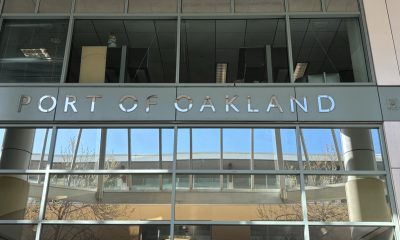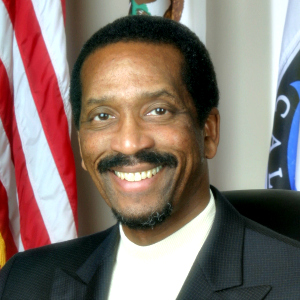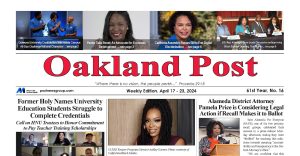Bay Area
Mayor Breed Announces Investments to Support Small Business Recovery in San Francisco’s Economic Core
“While San Francisco is bouncing back from this pandemic, we continue to see major shifts in our city, and we see that in our Economic Core more than anywhere else,” said Breed. “I’ve been visiting businesses large and small, and while it’s clear we are all committed to adapting and thriving as part of our long-term recovery, our small businesses in these downtown areas cannot wait any longer. They need all of us dedicating our energy and resources to help them in the short-term, as we continue to do the work to get our city back on track.”

From Mayor’s Office
Mayor London N. Breed announced Tuesday $47.9 million in new funding to support the economic recovery of the City’s Economic Core that will be part of her proposed budget.
This will include new direct support for small businesses, as well as new events, activations, and public space improvements to support areas that rely on workers, tourists, and other visitors.
The funding proposal will also continue the City’s existing Ambassador programs located in areas like Mid-Market, Union Square, Downtown, South of Market, and along the Embarcadero.
These resources are aimed primarily at funding initiatives that directly support and drive foot traffic to the small businesses in San Francisco’s Economic Core, which includes Downtown, South of Market, Union Square, Civic Center, Yerba Buena, and Mission Bay.
These areas continue to experience ongoing and significant disruptions to the employee and tourist-based foot traffic that they relied on prior to the pandemic.
“While San Francisco is bouncing back from this pandemic, we continue to see major shifts in our city, and we see that in our Economic Core more than anywhere else,” said Breed. “I’ve been visiting businesses large and small, and while it’s clear we are all committed to adapting and thriving as part of our long-term recovery, our small businesses in these downtown areas cannot wait any longer. They need all of us dedicating our energy and resources to help them in the short-term, as we continue to do the work to get our city back on track.”
The Mayor’s Budget proposal includes:
- $10 million for direct grants and loans aimed at helping small businesses launch, stabilize, scale up and adapt business models. New funding will expand programs to serve businesses throughout the City, including businesses within the Economic Core.
- $10.5 million over the two years for the City Core Recovery Fund to support events, public space and ground floor activations, as well as a city-wide marketing campaign. This funding is envisioned to support community driven efforts to beautify, improve, and activate public spaces and ground floor vacancies throughout the Economic Core.
- $25.4 million over the next two years to continue the Mid-Market/Tenderloin Community-Based Safety Program, which provides community ambassadors who are focused on creating more welcoming, clean, and vibrant environments for residents, workers, and visitors in the areas around the Tenderloin, Civic Center, and Market Street.
- $2 million for SF Welcome Ambassadors and Retired Police Community Ambassadors stationed in key transit and tourist nodes such as Downtown BART stations, Union Square, Moscone Convention Center, and along the Embarcadero.
These funds will maintain the City’s current investment and will allow for a consistent and visible safety presence as well as proactive positive engagement and friendly assistance in wayfinding, making referrals and recommendations, and coordinating with other City departments and community-based efforts to support positive street conditions and experiences by business owners, employees, residents, and visitors alike.
The specific programming and initiatives created through this funding will be informed by convening key representatives of the industries, businesses, community groups, and other stakeholders in the Economic Core to understand and respond to the immediate needs and challenges those on the ground are experiencing, and to adopt and scale the solutions they are developing.
“San Francisco small businesses are the cornerstone of our economic recovery. Through the leadership of Mayor Breed, these proposed investments are practical solutions that will help bring customers and visitors back into our Economic Core which comprises over 40% of our small businesses,” said Kate Sofis, executive director of the Office of Economic and Workforce Development. “As the dynamic continues to change and shift on the ground, we want to ensure we stabilize our small businesses, including our local artists, musicians, and performers with new funding and programs that activate and create opportunities and a safe and welcoming space for everyone. When our small businesses thrive, our city thrives.”
Mayor Breed partnered with Advance SF to create the “Renewing San Francisco’s Economic Core Forum,” a facilitated conversation with a cross-section of stakeholders from the Economic Core including large and small businesses, arts groups, brokers and real estate representatives, hospitality and entertainment establishments, and community benefits districts, among others.
This group began a process to develop a shared vision for supporting the ongoing vibrance of the Economic Core in the post-pandemic economic context and identify immediate needs as well as mid- and long-term initiatives to explore.
Through ongoing dialogue and discussion and in coordination with a broad set of stakeholders, San Francisco will continue to advance strategies that leverage key assets of its Economic Core to support its continued vibrancy and preserve its role in supporting the region’s economic well-being.
“Over the last several months, Advance SF has worked with the Mayor’s Office to bring private and public sector partners together to develop strategies to restore our Economic Core,” said Larry Baer, Co-Chair of Advance SF. “Mayor Breed is laser-focused on San Francisco’s post-pandemic recovery and the budget released today sets a clear vision to immediately address our city’s most pressing economic challenges,” continued Lloyd Dean, Co-Chair of Advance SF.
Prior to the pandemic, 469,745 people commuted to San Francisco for work. According to the most recent report from the City Economist, offices are seeing just 35% of their workforce returning to the office. Additionally, the City averaged 1 million annual tourists prior to the pandemic, and SF Travel does not estimate a full tourism recovery until 2024.
The Mayor’s proposed budget prioritizes the urgent needs of the small consumer-facing businesses in the Economic Core. Over 42% of the City’s small businesses are in the Economic Core and pre-pandemic, this area generated more than 45% of the City’s sales tax. While sales tax indicates that almost all of San Francisco’s neighborhoods have recovered the vast majority of the economic activity they generated prior to the pandemic, San Francisco’s office and tourist districts, including the Financial District, East Cut, Yerba Buena, Union Square, Mid-Market and SOMA maintain deficits of 20% or more.
“The challenges facing small businesses in San Francisco’s Economic Core are immense,” said Andrew Chun, owner of Schroeder’s Bar and Restaurant at Front and California Street. “As the rest of the City continues its recovery from the pandemic, it’s easy for Downtown small businesses to feel abandoned. The Mayor’s new budget highlights the need to proactively invest in a revitalized economic core. We are excited to work with the Mayor and appreciate the efforts of the City and community partners to invest in Downtown’s future.”
“Bringing foot traffic and business to our restaurants and small businesses in our downtown Economic Core area is critical to the survival and vibrancy of San Francisco,” said Laurie Thomas, executive director of Golden Gate Restaurant Association. “We continue to work hard with our partner organizations, larger employers and the City to help drive customers to these businesses so they can keep their staff employed and help their businesses open. We thank the Mayor and her team for prioritizing these restaurants and businesses in her budget and look forward to a continued partnership. We can do this if we work together.”
“As an employer with a large employee presence, we see the strain that the pandemic has created for our small businesses. We have worked in partnership with the small business community to ensure that as our employees return to the office, we are maximizing their support of surrounding small businesses that depend on them. With investments such as the City Core Recovery efforts that Mayor Breed has proposed the City can scale efforts like what we piloted with Golden Gate Restaurant Association to the benefit of all,” said Rebecca Prozan, Director of West Coast Government Relations and Public Policy at Google.
“Bringing people back to downtown is an important budget priority for our city. San Francisco is famously a city of neighborhoods, but all of us rely on the economic activity of the central business core of the City and its daily commuters and visitors,” said Andrew Robinson, Executive Director of the East Cut Community Benefits District. “The downtown is our economic engine; the small businesses, all the neighborhood corridors, all of the investments we make to keep our neighborhoods thriving rely on the health and vitality of our city’s core. The vitality of downtown is critical to our recovery—it is where people from across the City and region come to work, where tourists first set foot in our city, and where innovation thrives.”
“We’re optimistic about the recovery of downtown San Francisco and the cultural heart of Yerba Buena,” said Yerba Buena Community Benefit District Executive Director Cathy Maupin. “The clear uptick in tourism, conventions and hotel occupancy is bringing more and more people to the area to patronize small businesses, restaurants and cultural institutions. With the continued support and partnership of Mayor Breed and the City, we’re confident that this momentum and vibrancy will be sustainable.”
“Investing in the Economic Core of our city is essential to our overall recovery strategy,” said Joe D’Alessandro, President and CEO of San Francisco Travel Association. “The return on that investment will ensure that our small businesses can thrive as we once again welcome back business and leisure visitors to downtown and core neighborhoods reliant on tourism. It will also ensure that we can continue to bring back good jobs in the tourism and hospitality sector. Before the pandemic tourism supported more than 86,000 jobs in San Francisco compared to just over 27,000 in 2021.”
“Reimagining Downtown San Francisco is pivotal to the entire City’s vitality and Economic Core in this post-lockdown era. Yes, our world will look different as workers and companies adapt to a new reality. But as always, San Francisco will embrace this and be a catalyst for change with intentional evolution. We’ve always been a city on the cutting edge of progress and the past two years will not undo that forward-thinking precedent. Creating new public spaces, incubating small businesses, and giving arts and culture a new stage will be the backbone of our reimagined economy in Downtown SF,” said Robbie Silver, Executive Director of the Downtown Community Benefit District.
“Small businesses make our merchant corridors the unique and vibrant streets that we all love,” said Rodney Fong, president and CEO of the San Francisco Chamber of Commerce. “This investment from Mayor Breed celebrates those businesses and will help to return San Francisco’s Economic Core to the lively form it once held.”
“Mid-Market has been an abandoned landscape of vacant storefronts, drug dealing, and street crime for the past few years,” said Kash, the owner of Warm Planet Bikes at Market and McAllister. “The improved conditions of having Urban Alchemy on my block has been like night and day. More important, every practitioner I’ve talked with either has a second job or has a plan to transition to a stable career. This forward-thinking attitude is fundamental to the long-term success for the program and for the individuals moving through it and I strongly support that goal.”
Alameda County
DA Pamela Price Stands by Mom Who Lost Son to Gun Violence in Oakland
Last week, The Post published a photo showing Alameda County District Attorney Pamela Price with Carol Jones, whose son, Patrick DeMarco Scott, was gunned down by an unknown assailant in 2018.
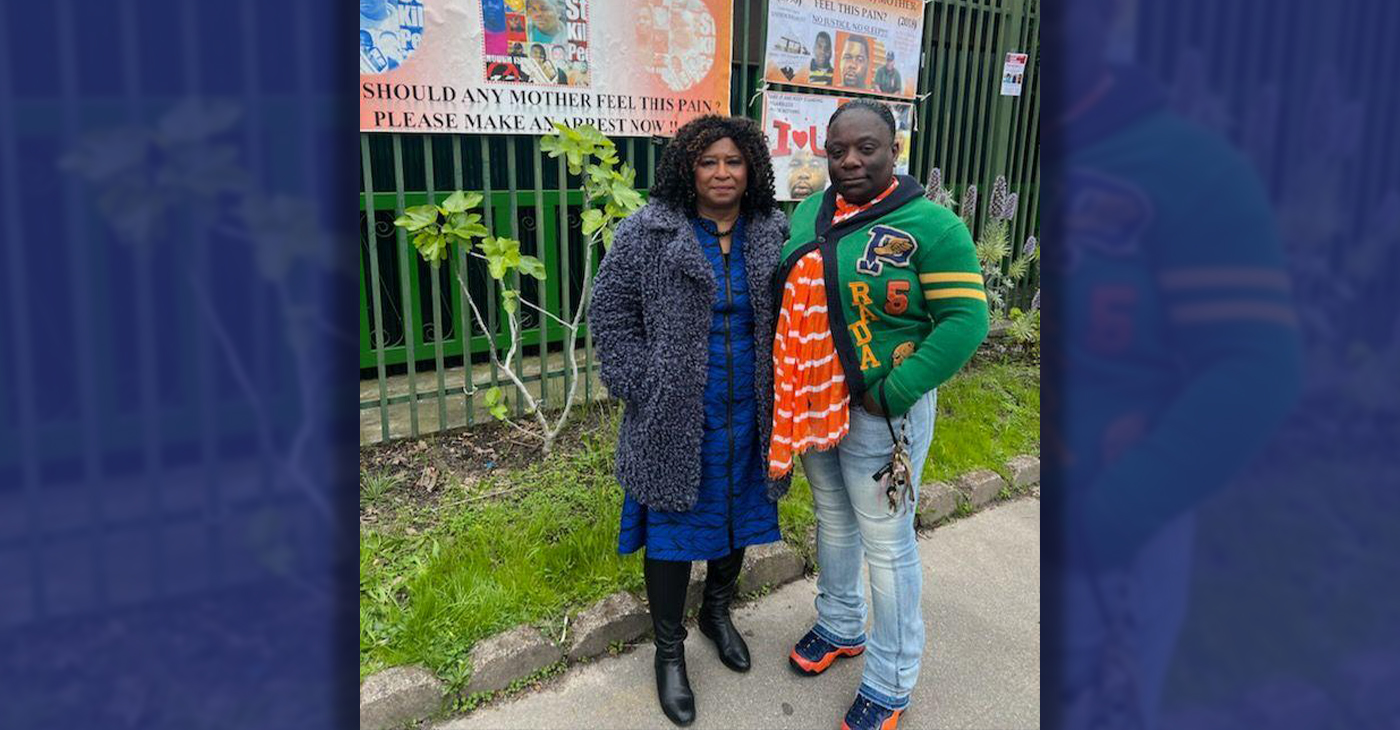
Publisher’s note: Last week, The Post published a photo showing Alameda County District Attorney Pamela Price with Carol Jones, whose son, Patrick DeMarco Scott, was gunned down by an unknown assailant in 2018. The photo was too small for readers to see where the women were and what they were doing. Here we show Price and Jones as they complete a walk in memory of Scott. For more information and to contribute, please contact Carol Jones at 510-978-5517 at morefoundation.help@gmail.com. Courtesy photo.
Bay Area
State Controller Malia Cohen Keynote Speaker at S.F. Wealth Conference
California State Controller Malia Cohen delivered the keynote speech to over 50 business women at the Black Wealth Brunch held on March 28 at the War Memorial and Performing Arts Center at 301 Van Ness Ave. in San Francisco. The Enterprising Women Networking SF Chapter of the American Business Women’s Association (ABWA) hosted the Green Room event to launch its platform designed to close the racial wealth gap in Black and Brown communities.
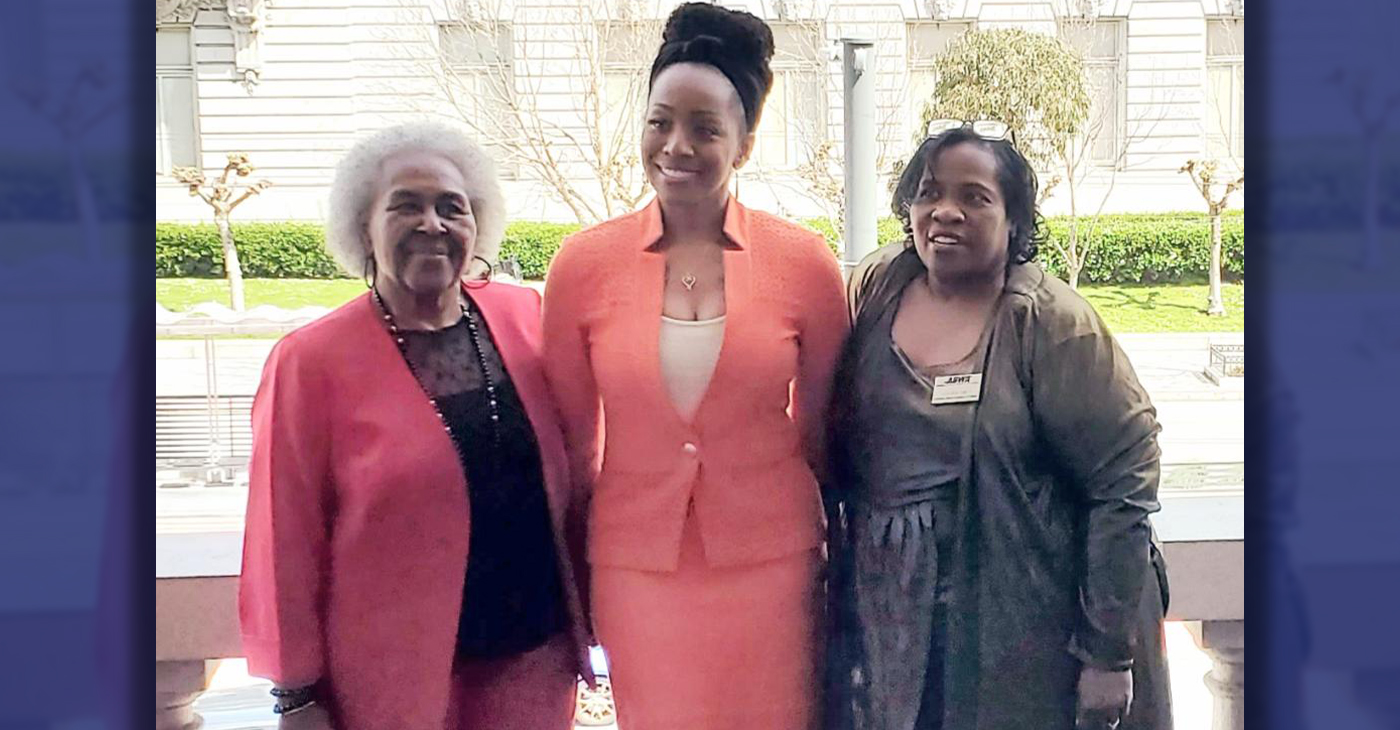
By Carla Thomas
California State Controller Malia Cohen delivered the keynote speech to over 50 business women at the Black Wealth Brunch held on March 28 at the War Memorial and Performing Arts Center at 301 Van Ness Ave. in San Francisco.
The Enterprising Women Networking SF Chapter of the American Business Women’s Association (ABWA) hosted the Green Room event to launch its platform designed to close the racial wealth gap in Black and Brown communities.
“Our goal is to educate Black and Brown families in the masses about financial wellness, wealth building, and how to protect and preserve wealth,” said ABWA San Francisco Chapter President LaRonda Smith.
ABWA’s mission is to bring together businesswomen of diverse occupations and provide opportunities for them to help themselves and others grow personally and professionally through leadership, education, networking support, and national recognition.
“This day is about recognizing influential women, hearing from an accomplished woman as our keynote speaker and allowing women to come together as powerful people,” said ABWA SF Chapter Vice President Velma Landers.
More than 60 attendees dined on the culinary delights of Chef Sharon Lee of The Spot catering, which included a full soul food brunch of skewered shrimp, chicken, blackened salmon, and mac and cheese.
Cohen discussed the many economic disparities women and people of color face. From pay equity to financial literacy, Cohen shared not only statistics, but was excited about a new solution in motion which entailed partnering with Californians for Financial Education.
“I want everyone to reach their full potential,” she said. “Just a few weeks ago in Sacramento, I partnered with an organization, Californians for Financial Education.
“We gathered 990 signatures and submitted it to the [California] Secretary of State to get an initiative on the ballot that guarantees personal finance courses for every public school kid in the state of California.
“Every California student deserves an equal opportunity to learn about filing taxes, interest rates, budgets, and understanding the impact of credit scores. The way we begin to do that is to teach it,” Cohen said.
By equipping students with information, Cohen hopes to close the financial wealth gap, and give everyone an opportunity to reach their full financial potential. “They have to first be equipped with the information and education is the key. Then all we need are opportunities to step into spaces and places of power.”
Cohen went on to share that in her own upbringing, she was not guided on financial principles that could jump start her finances. “Communities of color don’t have the same information and I don’t know about you, but I did not grow up listening to my parents discussing their assets, their investments, and diversifying their portfolio. This is the kind of nomenclature and language we are trying to introduce to our future generations so we can pivot from a life of poverty so we can pivot away and never return to poverty.”
Cohen urged audience members to pass the initiative on the November 2024 ballot.
“When we come together as women, uplift women, and support women, we all win. By networking and learning together, we can continue to build generational wealth,” said Landers. “Passing a powerful initiative will ensure the next generation of California students will be empowered to make more informed financial decisions, decisions that will last them a lifetime.”
Bay Area
MAYOR BREED ANNOUNCES $53 MILLION FEDERAL GRANT FOR SAN FRANCISCO’S HOMELESS PROGRAMS
San Francisco, CA – Mayor London N. Breed today announced that the U.S. Department of Housing and Urban Development (HUD) has awarded the city a $53.7 million grant to support efforts to renew and expand critical services and housing for people experiencing homelessness in San Francisco.

FOR IMMEDIATE RELEASE:
Wednesday, January 31, 2024
Contact: Mayor’s Office of Communications, mayorspressoffice@sfgov.org
***PRESS RELEASE***
MAYOR BREED ANNOUNCES $53 MILLION FEDERAL GRANT FOR SAN FRANCISCO’S HOMELESS PROGRAMS
HUD’s Continuum of Care grant will support the City’s range of critical services and programs, including permanent supportive housing, rapid re-housing, and improved access to housing for survivors of domestic violence
San Francisco, CA – Mayor London N. Breed today announced that the U.S. Department of Housing and Urban Development (HUD) has awarded the city a $53.7 million grant to support efforts to renew and expand critical services and housing for people experiencing homelessness in San Francisco.
HUD’s Continuum of Care (CoC) program is designed to support local programs with the goal of ending homelessness for individuals, families, and Transitional Age Youth.
This funding supports the city’s ongoing efforts that have helped more than 15,000 people exit homelessness since 2018 through City programs including direct housing placements and relocation assistance. During that time San Francisco has also increased housing slots by 50%. San Francisco has the most permanent supportive housing of any county in the Bay Area, and the second most slots per capita than any city in the country.
“In San Francisco, we have worked aggressively to increase housing, shelter, and services for people experiencing homelessness, and we are building on these efforts every day,” said Mayor London Breed. “Every day our encampment outreach workers are going out to bring people indoors and our City workers are connecting people to housing and shelter. This support from the federal government is critical and will allow us to serve people in need and address encampments in our neighborhoods.”
The funding towards supporting the renewal projects in San Francisco include financial support for a mix of permanent supportive housing, rapid re-housing, and transitional housing projects. In addition, the CoC award will support Coordinated Entry projects to centralize the City’s various efforts to address homelessness. This includes $2.1 million in funding for the Coordinated Entry system to improve access to housing for youth and survivors of domestic violence.
“This is a good day for San Francisco,” said Shireen McSpadden, executive director of the Department of Homelessness and Supportive Housing. “HUD’s Continuum of Care funding provides vital resources to a diversity of programs and projects that have helped people to stabilize in our community. This funding is a testament to our work and the work of our nonprofit partners.”
The 2024 Continuum of Care Renewal Awards Include:
- $42.2 million for 29 renewal PSH projects that serve chronically homeless, veterans, and youth
- $318,000 for one new PSH project, which will provide 98 affordable homes for low-income seniors in the Richmond District
- $445,00 for one Transitional Housing (TH) project serving youth
- $6.4 million dedicated to four Rapid Rehousing (RRH) projects that serve families, youth, and survivors of domestic violence
- $750,00 for two Homeless Management Information System (HMIS) projects
- $2.1 million for three Coordinated Entry projects that serve families, youth, chronically homeless, and survivors of domestic violence
In addition, the 2023 CoC Planning Grant, now increased to $1,500,000 from $1,250,000, was also approved. Planning grants are submitted non-competitively and may be used to carry out the duties of operating a CoC, such as system evaluation and planning, monitoring, project and system performance improvement, providing trainings, partner collaborations, and conducting the PIT Count.
“We are very appreciative of HUD’s support in fulfilling our funding request for these critically important projects for San Francisco that help so many people trying to exit homelessness,” said Del Seymour, co-chair of the Local Homeless Coordinating Board. “This funding will make a real difference to people seeking services and support in their journey out of homelessness.”
In comparison to last year’s competition, this represents a $770,000 increase in funding, due to a new PSH project that was funded, an increase in some unit type Fair Market Rents (FMRs) and the larger CoC Planning Grant. In a year where more projects had to compete nationally against other communities, this represents a significant increase.
Nationally, HUD awarded nearly $3.16 billion for over 7,000 local homeless housing and service programs including new projects and renewals across the United States.
-
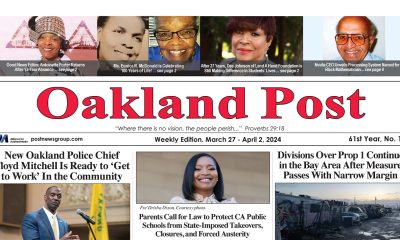
 Activism4 weeks ago
Activism4 weeks agoOakland Post: Week of March 27 – April 2, 2024
-

 #NNPA BlackPress4 weeks ago
#NNPA BlackPress4 weeks agoCOMMENTARY: D.C. Crime Bill Fails to Address Root Causes of Violence and Incarceration
-

 #NNPA BlackPress4 weeks ago
#NNPA BlackPress4 weeks agoMayor, City Council President React to May 31 Closing of Birmingham-Southern College
-

 #NNPA BlackPress4 weeks ago
#NNPA BlackPress4 weeks agoBeloved Actor and Activist Louis Cameron Gossett Jr. Dies at 87
-
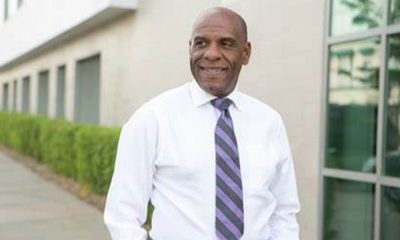
 Community1 week ago
Community1 week agoFinancial Assistance Bill for Descendants of Enslaved Persons to Help Them Purchase, Own, or Maintain a Home
-
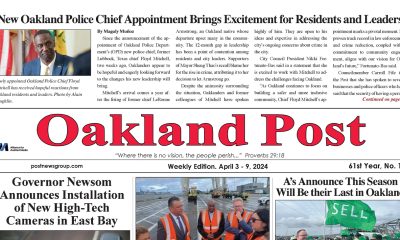
 Activism3 weeks ago
Activism3 weeks agoOakland Post: Week of April 3 – 6, 2024
-

 Business1 week ago
Business1 week agoV.P. Kamala Harris: Americans With Criminal Records Will Soon Be Eligible for SBA Loans
-
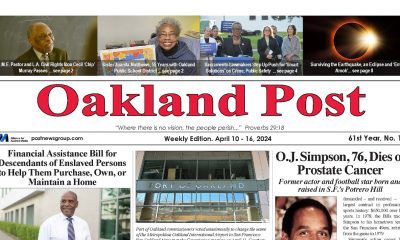
 Activism2 weeks ago
Activism2 weeks agoOakland Post: Week of April 10 – 16, 2024









